Four oils and lard, with Baked Bread fragrance
© 2011 by KV5R — Rev. Jan 1, 2011.
Shop for soap making supplies here.
Goals
- Design and make a well-balanced soap with one fat and 4 oils.
- Try a Fragrance Oil for the first time.
- Test my new soap recipe designer spreadsheet.
- Take more pictures (below) and write ya’ll up another web page.
My New Soap Recipe Designer Spreadsheet
I spent the past week completely rebuilding the Chris Mathes Soapsheet in OpenOffice Calc. My new version includes fat/oil properties (like soapcalc.com), with a normalized bar graph. Updated all the fat/oil/butter prices from extensive web searching. The new sheet also has dynamic scaling and soap volume calculations.
Once I had the ’sheet working right, it was lots of fun to change oils and weights, and watch the properties change on the graph. It instantly shows the interactions of the various oils’ properties, making it fairly easy to find a balanced mix, or push around any desired soap property.
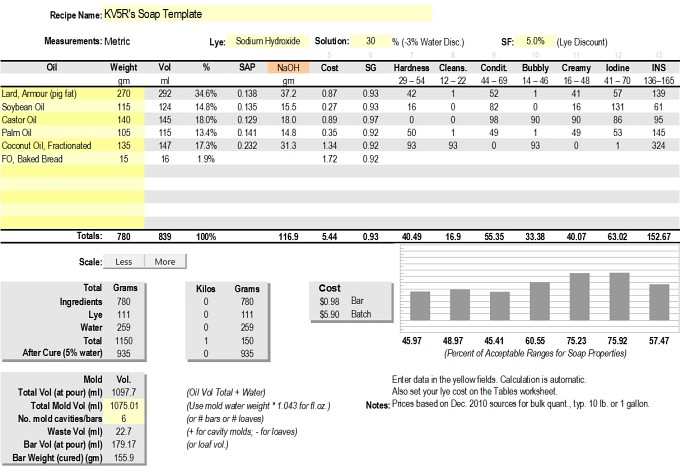
KV5R's Soap Recipe Designer Template for OpenOffice Calc
I started out designing a 4-oil recipe with what’s on-hand, including fractionated coconut oil. It just would not balance its properties. Then I added the lard and things started looking better. After another hour of fine tuning I hit upon the nice balance of properties that you can see in the graph.
Some soapers say that animal fat soaps clog your pores or are otherwise undesirable. Baloney. Once any fat/oil is saponified, it is no longer what it was—it’s now soap, not fat. The lard is cheap, and it helped balance properties the oils were missing. Here’s a shot of all the stuff I put in this batch:
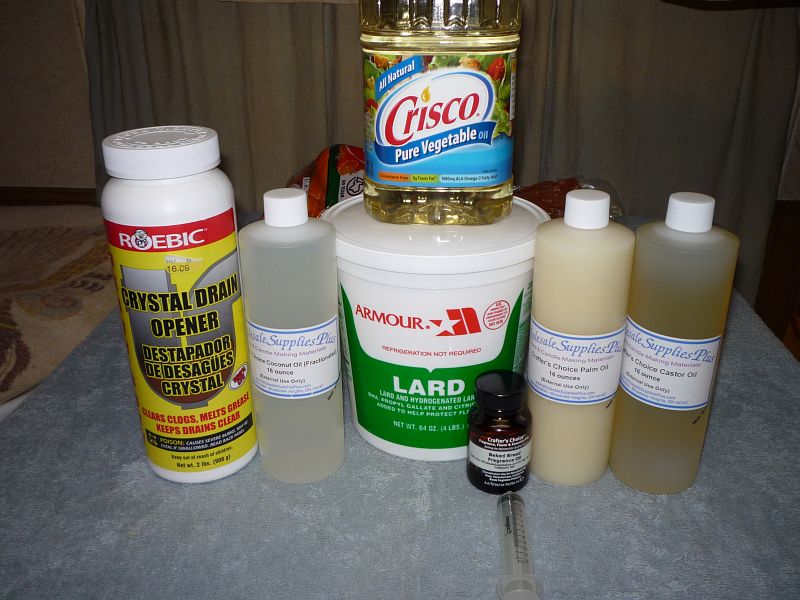
Ingredients
The Recipe
Developed using my new & improved soap recipe designer, with the goal of balancing all the properties near mid-range.
- 270 gm (34.6%) Armour Lard
- 115 gm (14.7%) Crisco soybean oil
- 140 gm (17.9%) Crafter’s Choice Castor oil
- 105 gm (13.5%) Crafter’s Choice Palm oil
- 135 gm (17.3%) Crafter’s Choice Coconut oil, fractionated
- 14 gm (1.8%) Crafter’s Choice “Baked Bread” fragrance oil
- 111 gm NaOH × 2.33 = 259 gm water = 30% caustic solution (a 3% water discount)
- 5% lye discount
- Target volume (at pour): ~1100 ml to fill the 1075 ml 6-cavity mold and allow a little waste.
The Proposed Procedure
This time I’ll get the lard and oils heated, weighed, and mixed first, then put all that oil stuff away, then make the caustic solution. I have such limited counter space!
- Weigh the lard into a bowl and microwave it for a minute. Stir. Microwave 30 seconds more. Now it’s clear.
- Warm the palm oil in the microwave for a minute. Shake bottle.
- Tare the pot and add the oils, weighing and taring each.
- Weigh the water in Pyrex measure and put in sink cooling & safety water.
- Weigh lye in a dry bowl and mix with the water. Stir. Avoid a few fumes.
- Warm the oils and cool the caustic solution to around 115°F.
- Pour the 30% caustic solution into the oils.
- Mix and stick-blend until light trace.
- Add the fragrance oil.
- Stick-blend to medium trace. Make sure fragrance is well-mixed.
- Pour into polyiso-insulated silicone cavity mold.
- Smooth top, cover and insulate.
- Clean up.
- Next day, un-mold and cure 4 weeks.
Total time: about 1 hour, including pictures and clean-up.
Results
The process went very well. From past experience, I planned to pour sooner and make prettier bars with smooth tops and no side bubbles. It took about 2 minutes to light trace and, after the FO, about 20 seconds more to medium. It was at pudding thickness by the end of the pour. This time, my volumetric calculations were perfect! The last bar was level with a good pot scraping.
Checked two hours later. Yep, it’s doing a nice warm gel phase. The weight on top of the polyiso insulation has the top of the soap nice and smooth. The baker’s parchment is a good mold cover: it lets out air bubbles, and doesn't stick to the soap (but it wrinkles later). These are gonna be perfect-looking square bars, requiring little or no trimming. Checked 6 hours later and it’s still in gel! The polyiso box works much better than a big towel, and is much easier to handle.
Pictures
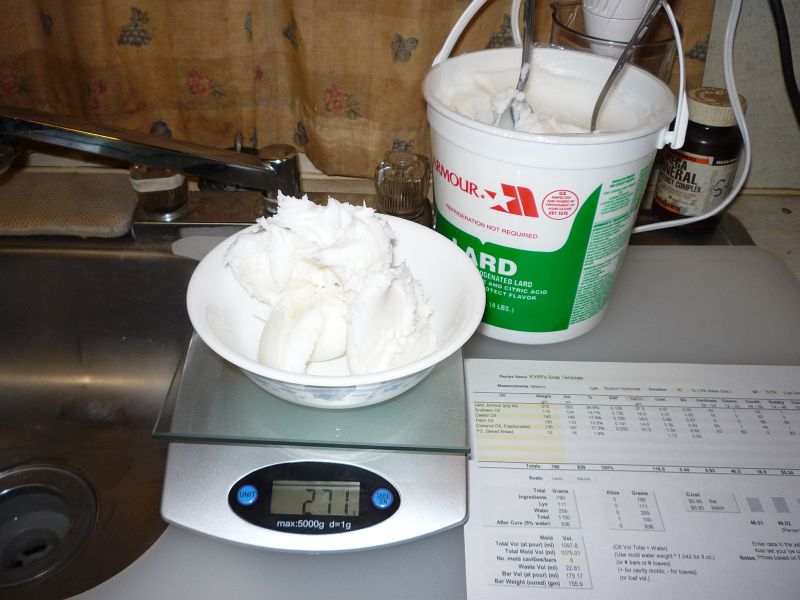
And so thare I was, justa waaaayin’ out them thare hawg rendrins…
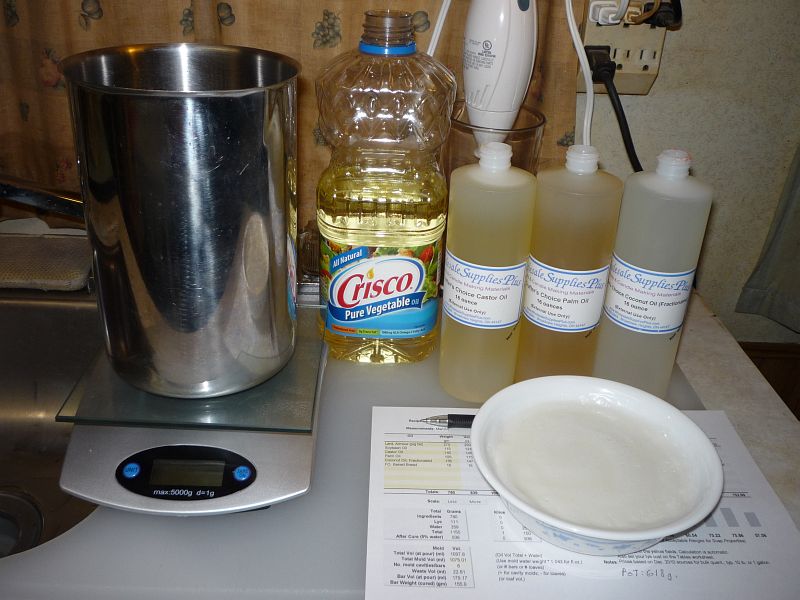
Hard oils (lard, palm) heated up; all lined up in list order…
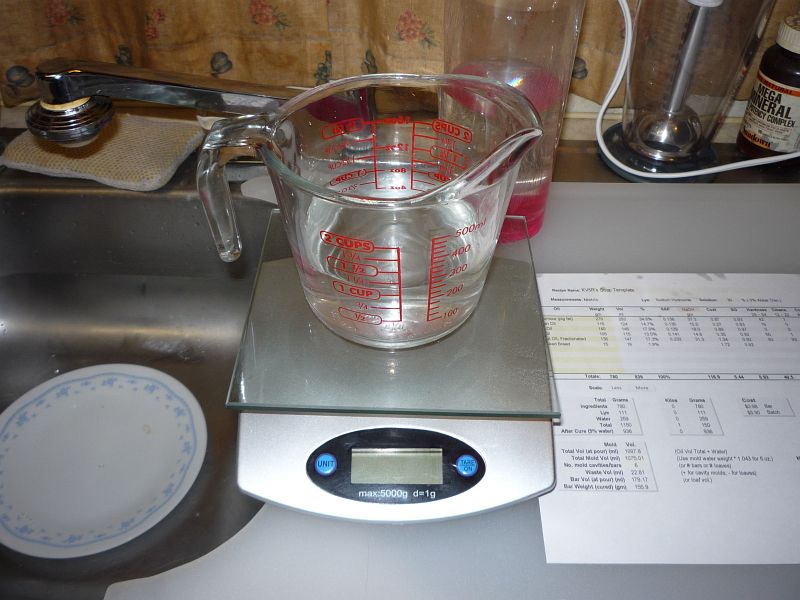
Weighing the water…
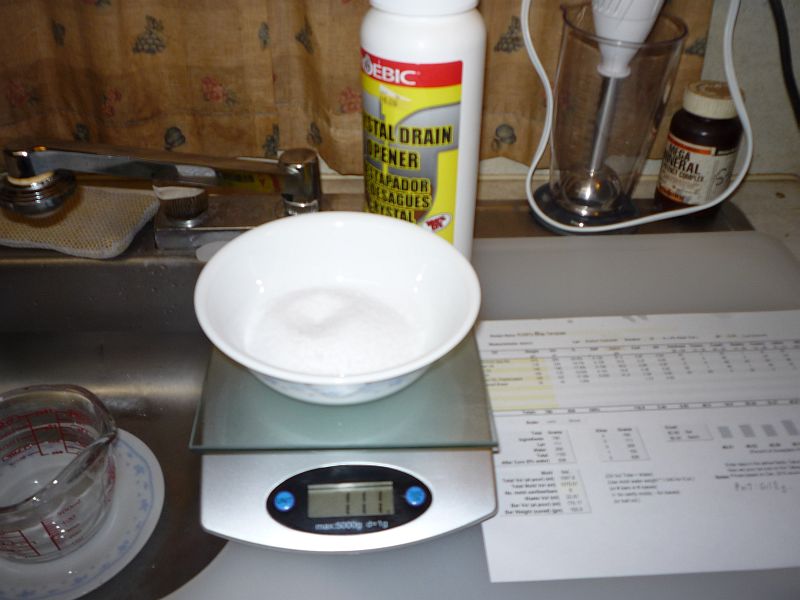
Weighing the lye… (oh my!)
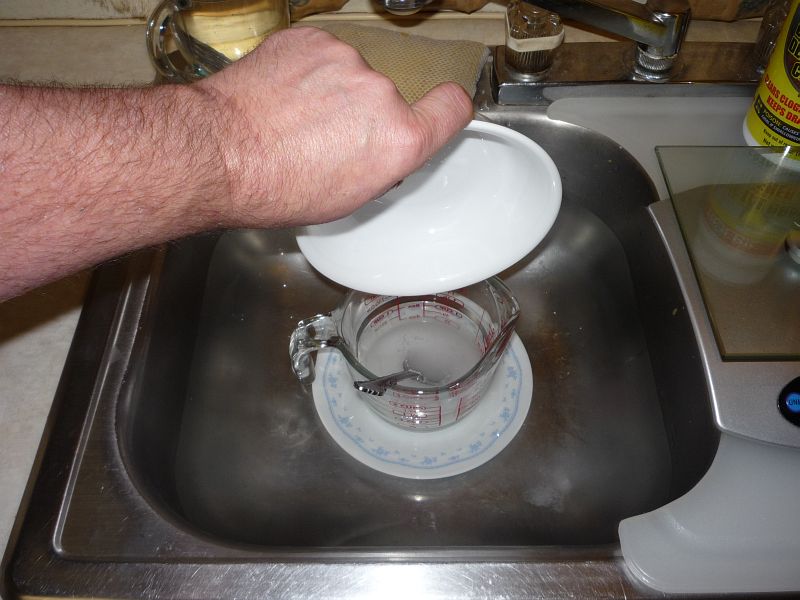
Dumping it in the water (carefully), then stirring it…
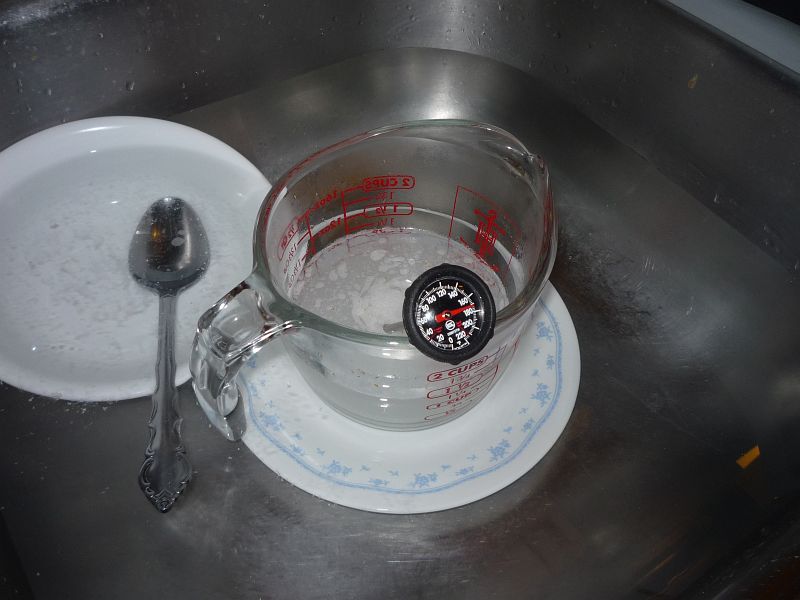
Instant hot caustic—exothermed to 175°F. Avoid the fumes!
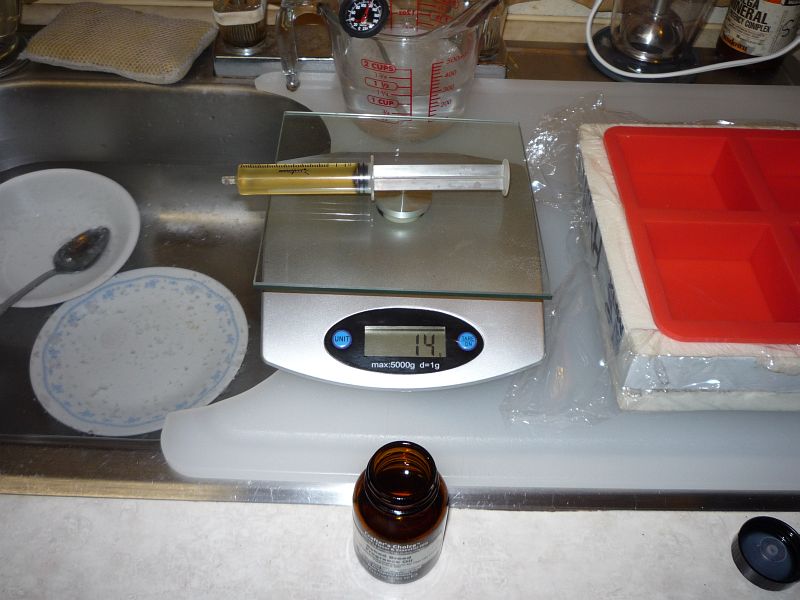
Weighing 14 grams of fragrance oil… (Yes, I tared the syringe first.)
Why 14? That’s 1.8% of the oil weight—3% is nominal, but I want it very light.
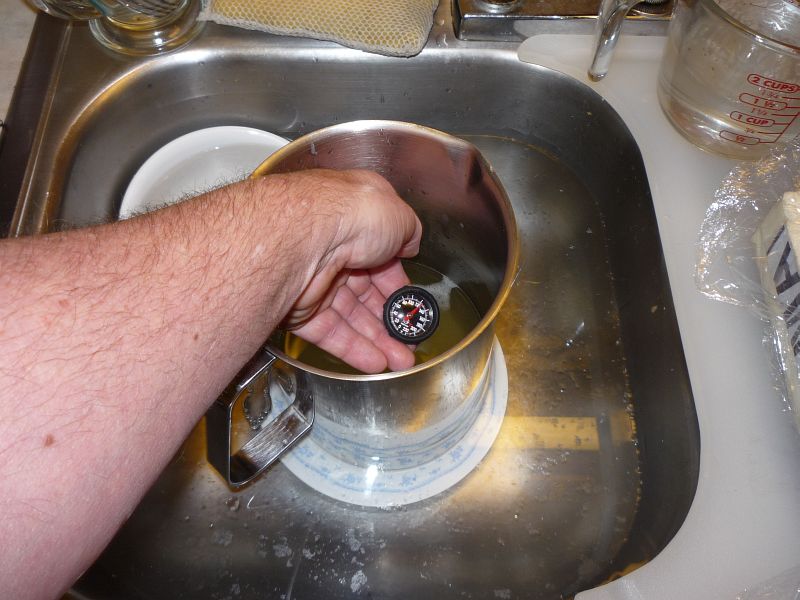
Oils at 121°F…
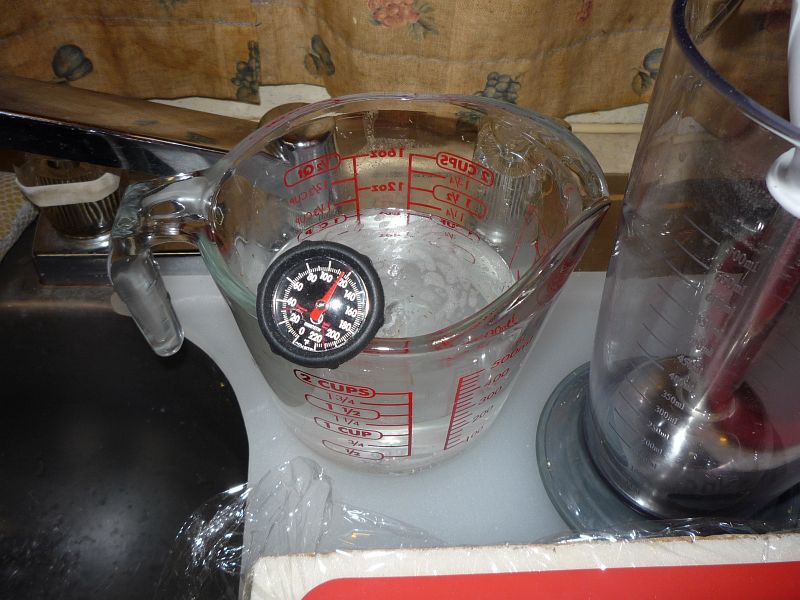
Caustic at 117°F… Close enough!

Pour it! Nice and smooth—no splashing…
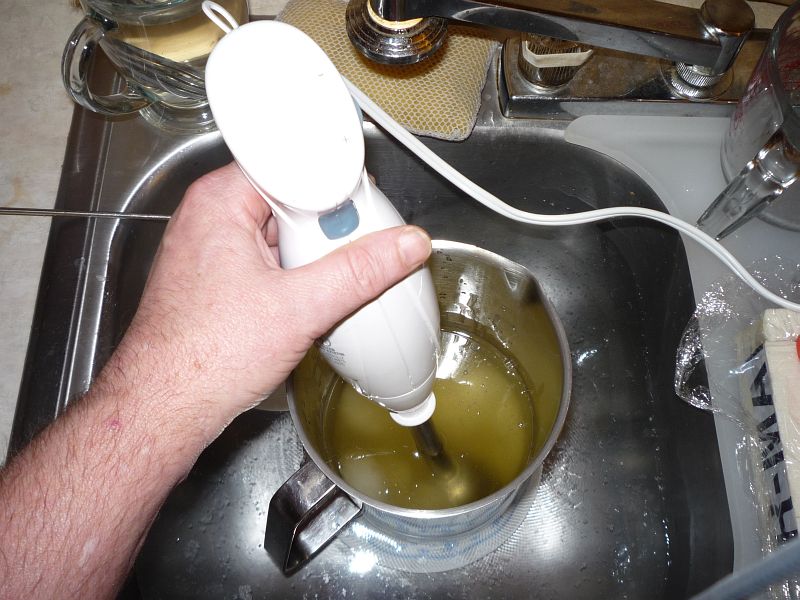
Whizz and stir… (about 2 minutes)
Check out that neato vibration pattern on the sink water!
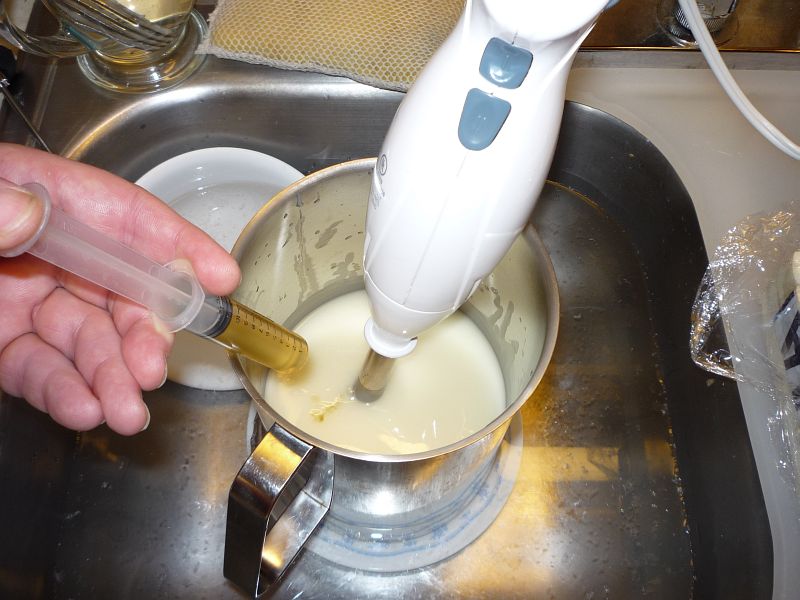
Light trace: shootin’ in the fragrance, then whizzin’ some more (~20 seconds)
There’s that “light custard” look they’re always talkin’ about…
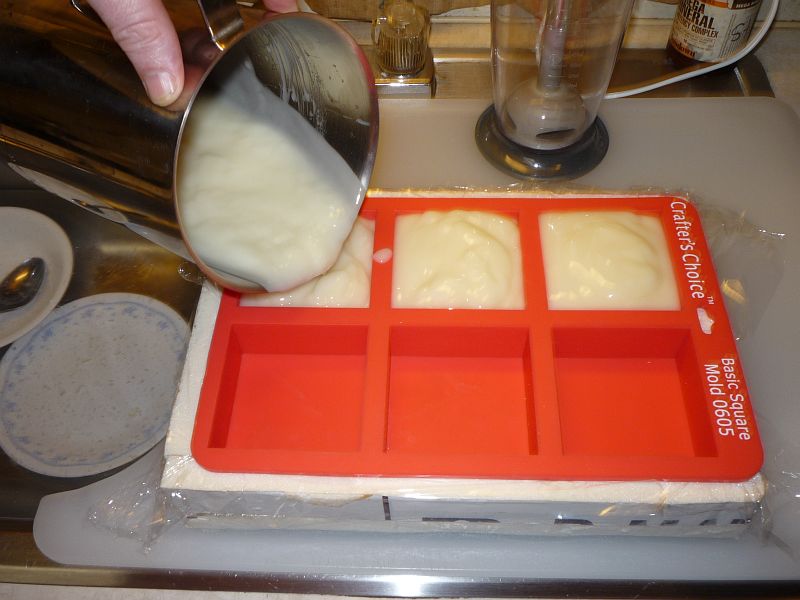
Hurry now! It’s rampin’ up fast! Pour!
It got a bit lumpy during pour. Is that from the FO? I donno.
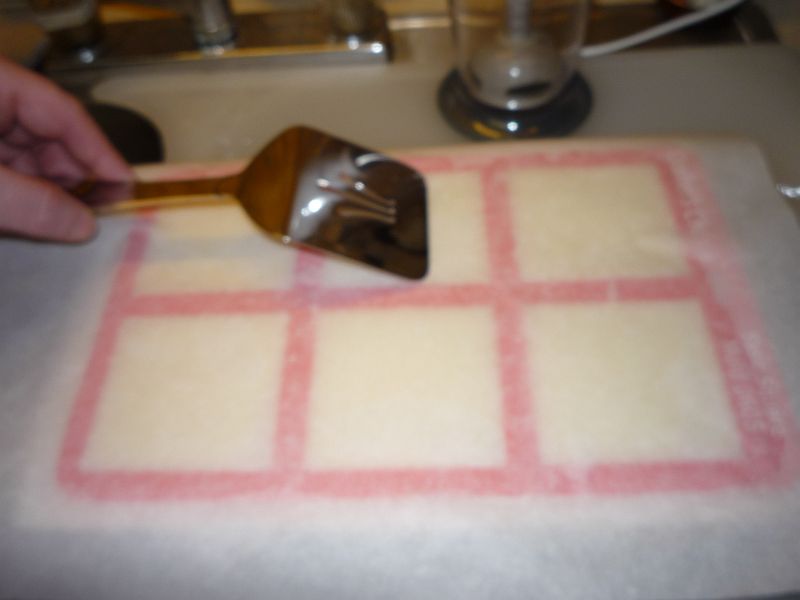
Cover with baker’s parchment and slick it out… (sorry, bad auto-focus)
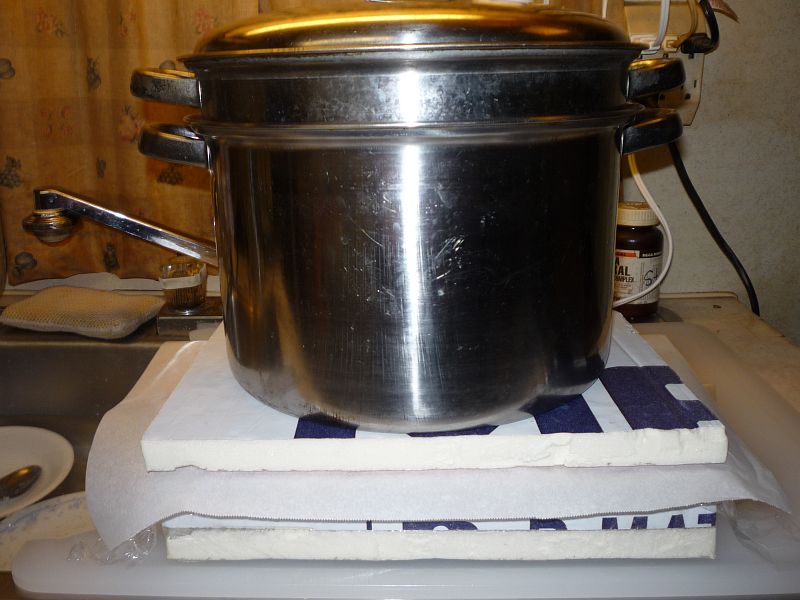
Cover with polyiso insulation and mash it down. All done.
Tomorrow: Un-molded about 15 hours later. Two minor disappointments: (1) the baker’s parchment wrinkled up a little, giving one side of the soap fine wrinkles, and (2) some wierd separation happened in one corner of one bar. It otherwise looks like a good batch.
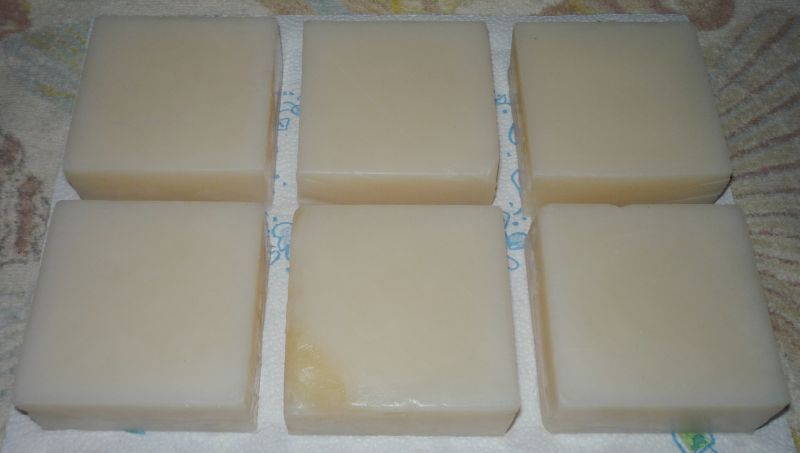
So there it is, ready for curing. Notice the one wierd corner? Donno.
Here’s the spreadsheet I used for this batch (PDF file). You can see the good balance of properties on the bar graph, which are derived from the properties in the sap table, which are based on the widely-used soapcalc.com properties scales. Note that I’ve also added volume calculations, which are derived from weights ÷ specific gravities, which are also in the sap table on sheet 1.
How Does It Work?
I showered with it a few days later. Handling it, it feels a bit greasy, but it isn’t—that’s just a silky soap that rinses off squeaky-clean! I like it. Good cleansing, creamy suds, and easy rinse. What more do you want? Shea butter? Avacados and cucumbers? I let Waggin’ sniff it with his picky one-part-per-billion nose, and he actually licked it! The Baked Bread FO that I sparingly used is just barely detectable, and mildly pleasant. I’m very happy with this batch—it’s a true luxury soap with well-balanced properties.
Concluding Thoughts
So there’s my fourth batch. What did I learn?
- My new soap recipe designer is like using soapcalc.com, but much faster, as it shows the properties on normalized scales as fast as you can adjust the weights of the oils. I tested the recipe on soapcalc.com and all the numbers were almost identical.
- Using lard and 4 oils allows one to adjust the recipe until all the properties are well balanced. For example, you don’t have to sacrifice hardness for conditioning, or cleansing for lather.
- The main thing requiring considerable experience is knowing exactly when to pour. The reaction starts off slow, then ramps up quickly, sorta like an exponential curve. Once it hits medium trace, every second matters.
- The fragrance oil didn’t do anything wacky during trace, as many do, but it may have made the mix a bit lumpy during pour, as if the reaction was unevenly distributed (but it wasn’t). Using the FO at about ½ the recommended amount (which is ½-ounce per pound) gave it a barely-detectable scent—exactly what I wanted. As I’ve explained before, I choke on heavy scents.
- Don’t use fractionated coconut oil—it has very high numbers in some properties, very low in others, making one “push” the other oils to compensate. Regular 76° coconut is easier to use in a recipe design, and it’s cheaper.
- The baker's parchment is a good idea for slicking out the top, but the moisture made it wrinkle overnight during gel phase. Will try wax paper next time. (Cling wrap traps air bubbles.)
- Sorry WSP, but that fragrance doesn’t smell like baked bread. It’s not bad—but it’s not bread. Maybe it’ll get better with curing time (it did).
- Making soap gets easier and more fun with every batch! And every one is different.
I found 76° coconut oil at Walmart, LouAna, $5.25 a pound. I’ll be using that with soybean, palm, and castor in the next two batches, which will be flavored with Clary Sage EO and a brushed leather FO. Shoud be nice!
Stay tuned for more in the coming weeks. My next batch will be a winter moisturizing bar, with the cleansing pushed way down and the conditioning pushed way up. Sorta between a bath bar and a facial bar.
So until the next batch, good soaping! —KV5R

Hi Harold, I’d like to reproduce your photo showing the Four-Oil Soap ingredients in my upcoming
biochemistry textbook. Please email me your email so that I may email you a formal request letter.
No, you can’t use my images (or text) in any publication, as that would require a complex and expensive contract.
Besides, that’s a rather lousy recipe – I used the lard just to compensate for the properties of the fractionated coconut oil I had on-hand. A much better recipe is like this: equal parts (25% by weight each) of coconut, olive, palm, and castor oils. That makes the perfect soap: great cleansing, moisturizing, and super-creamy lather.
Why a soap recipe in a biochemistry book?
You can, of course, set up your own ingredients and make your own image; that’s a lot simpler than using someone else’s image.
Best Wishes,
–kv5r